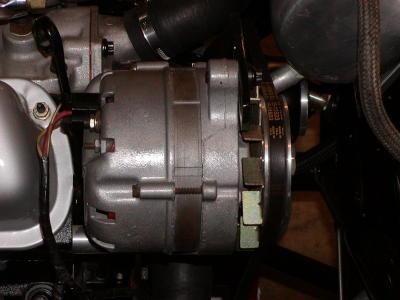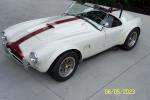 
 Main Menu
Main Menu
|
 Nevada Classics
Nevada Classics
|
 Advertise at CC
Advertise at CC
|
| S |
M |
T |
W |
T |
F |
S |
| |
|
|
|
|
|
1 |
| 2 |
3 |
4 |
5 |
6 |
7 |
8 |
| 9 |
10 |
11 |
12 |
13 |
14 |
15 |
| 16 |
17 |
18 |
19 |
20 |
21 |
22 |
| 23 |
24 |
25 |
26 |
27 |
28 |
|
|
 CC Advertisers
CC Advertisers
|
|

05-09-2004, 10:57 AM
|
 |
Ouch Ouch Hot Sand

|
|
|
Join Date: Jul 2003
Location: Daytona Beach,
FL
Cobra Make, Engine: Street Beasts w/302 Twin Turbocharged....Under Construction!!
Posts: 1,796
|
|

 Not Ranked
Not Ranked
 Which way did he go, which way did he go??
Which way did he go, which way did he go??
On a serious note, which way do I go....5.0 motor, 1989, time to purchase an Altenartor...stock, 130, 140, 150, or all the way to the 200 amp??? Any advice would be appreciatated!!!
__________________
Safe Flyin, errrrr Drivin, Earl

|

05-09-2004, 02:21 PM
|
 |
CC Member

|
|
|
Join Date: May 2000
Location: Leicester,
UK
Cobra Make, Engine: Crendon, windsor 408 stroker, tremec. Also GSX008
Posts: 1,406
|
|

 Not Ranked
Not Ranked
IMHO, the electrical demands on a Cobra are so minimal that a stock alternator is more than adequate. Unless you are fitting 3 squillion watts of ICE, ( in which case...why???) stock rating is more than enough.
__________________
Wilf
|

05-09-2004, 05:05 PM
|
 |
Ouch Ouch Hot Sand

|
|
|
Join Date: Jul 2003
Location: Daytona Beach,
FL
Cobra Make, Engine: Street Beasts w/302 Twin Turbocharged....Under Construction!!
Posts: 1,796
|
|

 Not Ranked
Not Ranked
Anyone else, MrMustang, Mrfixit, anyone???????
__________________
Safe Flyin, errrrr Drivin, Earl

|

05-09-2004, 09:16 PM
|
 |
CC Member

|
|
|
Join Date: May 2001
Location: California,
Ca
Cobra Make, Engine: NAF 289 Slabside Early Comp Car with 289 Webers and all the goodies. Cancelling the efforts of several Priuses
Posts: 6,592
|
|

 Not Ranked
Not Ranked

I use this 1964 Ford 42 amp alternator with an external regulator. It is the OEM type for a 289 Car, although outdated by todays standards it has served me well for many years and therefore I chose to continue using it when I rewired the car last Winter. I have the typical lights, Spal fan, mechanical gauges with lights in them, MSD-6T ignition, turn signals, brake lights and 3 relays used throughout the system. The only time I had any problems was when I chose to run a reduced diameter crank pulley and in town it did not develop enough current due to reduced RPM. I just think the high amperage units are overkill if you do not have accesories that require it.
Rick
__________________
Rick
As you slide down the Banister of Life, may the splinters never be pointing the wrong way 
Last edited by Rick Parker; 05-09-2004 at 10:26 PM..
|

05-10-2004, 07:05 AM
|
 |
Senior Club Cobra Member

|
|
|
Join Date: Dec 2001
Location: Shasta Lake,
CA
Cobra Make, Engine:
Posts: 26,599
|
|

 Not Ranked
Not Ranked
Agree with al of the above, but battery location could also add to the accessory drain if you have anything more than your gauges. You knonw, the $40K sound system, Movie screen in the dash, and stuff like that.
Ron  |

05-10-2004, 03:02 PM
|
|
CC Member

|
|
|
Join Date: Oct 2003
Location: Tampa,
FL
Cobra Make, Engine: no cobra, 71 Rx2 460windsor
Posts: 117
|
|

 Not Ranked
Not Ranked
I had an 86 mustang years ago and put a 100 amp alternator on it, and had nothing but PROBLEMS!~!!... It was always burning up, and I had to keep replacing the diodes. I asked a few Ford guys about it, and they said it was because i wasnt using enough power and the alternator was creating to much power with no where to go. I ended up switching back to the normal alt and it solved the problem.
|

05-11-2004, 05:07 AM
|
|
Shade Tree Mechanic

|
|
|
Join Date: Oct 2000
Location: La Plata,
MD
Cobra Make, Engine: - Unique - 302 - 4 spd. -
Posts: 680
|
|

 Not Ranked
Not Ranked

Quote:
Originally posted by brainsboy
I had an 86 mustang years ago and put a 100 amp alternator on it, and had nothing but PROBLEMS!~!!... It was always burning up, and I had to keep replacing the diodes. I asked a few Ford guys about it, and they said it was because i wasnt using enough power and the alternator was creating to much power with no where to go. I ended up switching back to the normal alt and it solved the problem.
|
Now that's one electrical problem I've never seen!!!..... I think you were told a major untruth. An alternator is an on-demand type of thing. If you have no load applied to it (just spinning and not powering anything) it will just sit there and spin. It is not generating any POWER if nothing is connected to it. If you have a 100 amp alternator, and you are powering a device that only requires 25 amps, the alternator will coast along and last a long time running at 1/4 of it's design limit. However, if you have a 100 amp alternator and are trying to power a device that requires 150 amps, then the poor alternator will slowly destroy itself because you have exceed the limits of the devices that make up the alternator. The formula for power in direct current circuits is Power (WATTS) is equal to the Voltage (VOLTS) times the Current (AMPS). Since the voltage in our cars is nominally 13.6 volts, the only other variable in our formula is the current...... or what the various electrical things in our cars need to operate. So there is NO excess power generated if it isn't needed.......
- Jim -
__________________
- Jim Harding -
- Capital Area Cobra Club -
- Just another day in Cobra Paradise -
|

05-11-2004, 05:59 AM
|
 |
CC Member

|
|
|
Join Date: Nov 1999
Location: Pentwater,
Mi
Cobra Make, Engine: Professional Cobra & Streetrod Builder
Posts: 5,352
|
|

 Not Ranked
Not Ranked
AND now Chapter two of the alternator topic:
Tell us in DV--layman terms about the new "one" wire alternator.
Appearing to be a true miracle for us waining in electrical knowledge. It just seems to good to be true! How does it work?
DV...just another mystery of life  |

05-11-2004, 06:06 AM
|
|
CC Member

|
|
|
Join Date: Jul 2003
Location: Cleveland,
OH
Cobra Make, Engine: SPF1670 Stroked Little Windsor - Runs OK.
Posts: 1,244
|
|

 Not Ranked
Not Ranked
DV - I have the Powermaster 1-wire alternator hoooked up in my SPF. I can do "layman" terms because that's the extent to which I understand it. As far as I know, it is internally regulated and therefore it only needs 1 wire and no external voltage regulator. It seems to work really nicely. I have not had any issues at all, but only have about 1100 miles on the car so far.
PS - DV, your mailbox is full. 
__________________
J.P.
Ohio Cobra Club
Token Gashole
|

05-11-2004, 09:13 AM
|
 |
CC Member

|
|
|
Join Date: Feb 1999
Location: Kansas City,
MO
Cobra Make, Engine: CRL, 351W, Tremec TKO
Posts: 2,299
|
|

 Not Ranked
Not Ranked

The one-wire alternators are the way to go (in my opinion).
(Gross oversimplification follows... )
A normal alternator needs a battery hooked up to it so that the field windings become energized. With the field windings energized the rotor windings spun by the pulley can produce electricity. The faster the engine spins the faster the rotor spins and the more electricity is produced. Problem is, we want to keep the output of the alternator around 13.8 volts.
So to keep the output at 13.8 volts the voltage regulator changes the amount of current flowing into the field windings. Less current in the field = less output voltage from the alternator.
A one-wire alternator does all of this with an internal regulator. When the engine is first spun up the one-wire alternator takes a little bit of current from the battery to initialize the field windings. Once the alternator is producing current it can energize it's own field windings (through it's internal voltage regulator) and really doesn't even need to be connected to the battery anymore.
One down-side to a one-wire alternator is that you loose your charge-failure lamp (the one that says "ALT"). Most one-wire alternators have a way of adding the ALT lamp, but I just use a voltmeter instead.
__________________
Pete K.
Who is John Galt?
|

05-11-2004, 03:34 PM
|
 |
CC Member

|
|
|
Join Date: Nov 1999
Location: Pentwater,
Mi
Cobra Make, Engine: Professional Cobra & Streetrod Builder
Posts: 5,352
|
|

 Not Ranked
Not Ranked
Petek,
I was hoping you would jump in on this. My curiosity is how does the current flow in both directions? To the battery, then back to the internal regulator saying I've got enough. Is it simply a matter of resistance?
Thinking about eliminating the OEM chrysler alternator on our DV's and replacing them with a one wire. Seems the ECM on Vipers IS the regulator. We've found out that there is a slight voltage drop through this process. If we give the motor a full 12+ volts it's like adding 50 horsepower! I'm serious, RPM will jump over 200 to 300 RPM.
Still trying to figure this one out. Thoughts?
DV...I love a challange...on "your" car!  |

05-11-2004, 03:40 PM
|
 |
CC Member/Contributor

|

|
|
Join Date: Feb 2000
Location: Greenville,
SC
Cobra Make, Engine: 70 Shelby convertible, ERA-289 FIA, 65 Sunbeam Tiger, mystery Ford powered 2dr convertible
Posts: 12,739
|
|

 Not Ranked
Not Ranked
Earl,
A stocl altenator is just fine for your application...Unless of course your planning a "Thumper" sound system, neon lights underneath the car, engine compartment, and trunk, and a TV/DVD system in your dashboard. Anything else is overkill.............
Bill S.
PS: One wire alternators have a "self exciting" sensor switch installed. meaning that as soon as your starter cranks the engine, thus turning the alternator pulley, the alternator starts charging up the system.
__________________
Instead of being part of the problem, be part of a successful solution.
First time Cobra buyers-READ THIS
|

05-11-2004, 04:10 PM
|
 |
CC Member

|
|
|
Join Date: Feb 1999
Location: Kansas City,
MO
Cobra Make, Engine: CRL, 351W, Tremec TKO
Posts: 2,299
|
|

 Not Ranked
Not Ranked

DV,
How does current flow "both ways" whey you jump a car? Same sort of thing is going on.
With the alternator once the engine is spinning fast enough, the alternator is producing enough electricity to keep itself going. So initially the current is flowing from the battery to the field winding of the alternator, when the engine spins fast enough the voltage produced by the alternator is high enough that the current flows the other way (into the battery).
I wouldn't think there would be a problem at all with replacing the alternator on your car with a one-wire one. The ECU just won't control the voltage any more. If you wanted to get real tricky you could probably fake out the ECU by modifying the signals from the current alternator. Bring the standard voltage up to say 16 volts. Of course you'd need to replace the battery with a 16 volt battery!
I had an alternator go out on my car ... happened the same day my father was visiting. Car ran like poop when the ECU was running on battery power only. Charging the battery up before a run helped a LOT. Funny how things like the spark box and FI control don't like low voltage.
Interestingly the spark box (Holley) is designed to work with up to something like 24 volts! I don't know how many more joules would be produced with 24 volts, but I'm guessing you could arc weld with the spark controller box!
__________________
Pete K.
Who is John Galt?
|

05-11-2004, 07:32 PM
|
 |
Senior Club Cobra Member

|
|
|
Join Date: Jan 1999
Location: MARKSVILLE,LA.,,
Posts: 3,235
|
|

 Not Ranked
Not Ranked

DV;
I have a had a little expirience with one-wire alternators;here goes,bought the PowerMaster for around 150 bucks,lasted a few months,regulator was faulty,burnt up,produced 22 volts,burnt up the MSD box,sent it back at my expense,they checked it out,called me to tell me the voltage regulator was "faulty" and they would fix it for me FREE and have it back to me in five working days,they refused to pay for the MSD box........Five days turned out to be three weeks,so I went to Auto-Zone,bought the el-cheapo 19.95,60 amp,stock Ford unit,lifetime warranty,went to the local alternator shop bought the voltage regulator for 39.95,installed in two minutes,had the guy test it,it tested perfect,been on my car now over five years and 20,000+ miles,no problems,PowerMaster still in the box as they sent it back to me,sitting on the shelf..........
The voltage regualtor is a small silver little box about the size of a book of paper matches that screws on the back of the alternator and has three little wires coming out that go on the back of the alternator,instructions with the voltage regulator,even I got it right on the first try,one big red wire comes off the back of the alternator to the battery side of the starter selonoid,that's it.......BTW,when you start the engine the alternator WILL NOT start charging right off,it takes anywhere from 1500 to 2400 rpms before it "excites" or "turns on" depending on your pulley size,with my stock pulleys it comes on at 1500 rpms,with underdrive pulleys you may have to blip it to 2200 to 2400 rpms,once it is on,it will now charge at any rpm...........I can not remember which ones,but I know they sell the regulators in some of the Mustang magazines.....
Since my car is a 65 Mustang,and all I have is an electric radiator fan,am/fm/cassette,and MSD box the 60 amp has been more than enough..........I'll try to post some pics tomorrow....
Hope this helps..........
David 
__________________
DAVID GAGNARD
Last edited by DAVID GAGNARD; 05-12-2004 at 10:46 AM..
|
 Posting Rules
Posting Rules
|
You may not post new threads
You may not post replies
You may not post attachments
You may not edit your posts
HTML code is Off
|
|
|
All times are GMT -7. The time now is 02:03 PM.
Links monetized by VigLink
|


